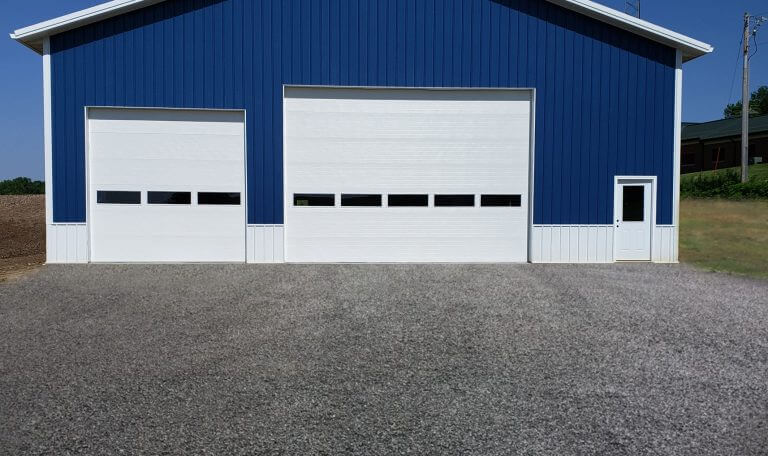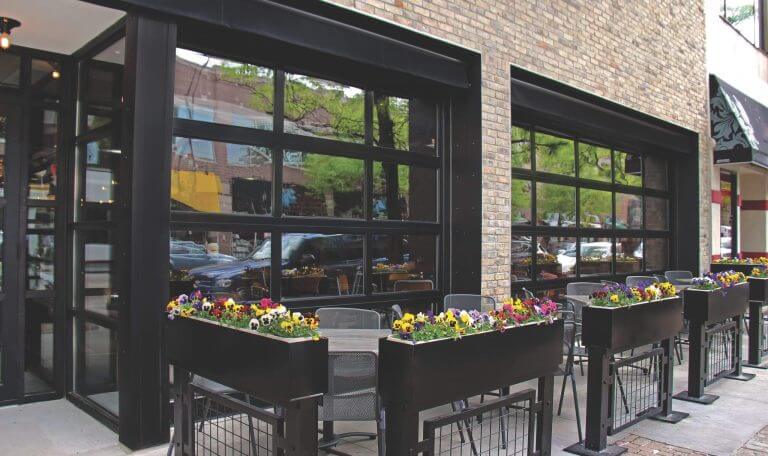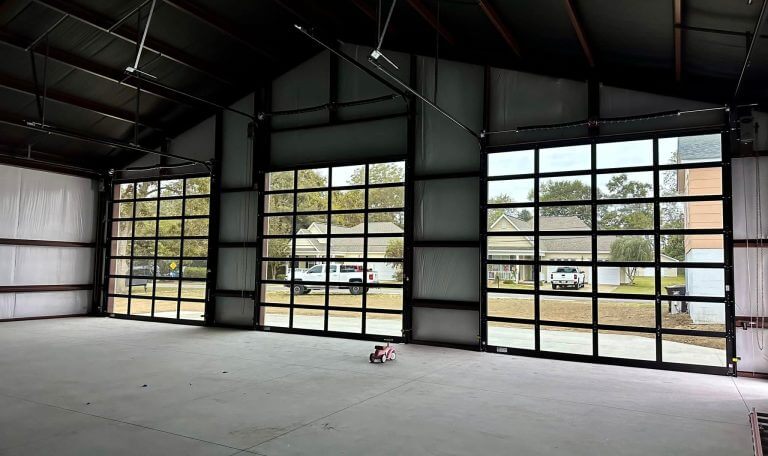Commercial overhead doors are critical components for many businesses, providing security, climate control, and operational efficiency. When functioning properly, these doors protect inventory, regulate temperature, and facilitate smooth daily operations. However, like all mechanical systems, they eventually wear out and require replacement. Making this decision at the right time can prevent costly emergency situations, improve energy efficiency, and enhance your facility’s security, especially in loading dock areas. This guide will help you identify when a replacement is necessary and what to consider when upgrading your commercial overhead door.
Understanding Commercial Overhead Doors
Commercial overhead doors are vital for businesses, offering security, access control, and protection against the elements. Unlike residential garage doors, commercial garage doors are built to withstand heavy use and are designed for industrial applications. Understanding their construction, operation, and maintenance requirements is essential for any business owner looking to optimize their facility’s functionality and the door’s longevity.
Types of Commercial Overhead Doors
The most common commercial overhead door types include:
- Sectional Doors: Consisting of horizontal panels that roll up along tracks, these are the most common commercial doors. They offer good insulation and security while being relatively cost-effective.
- Rolling Doors: Made of interlocking slats that coil around a drum above the opening, these doors are ideal for high-security applications and spaces with limited headroom.
- High-Speed Doors: Designed for high-traffic areas, these doors open and close rapidly to maintain climate control and improve operational efficiency.
- Fire-Rated Doors for Residential and Commercial Use: Specifically engineered to slow the spread of fire, these doors are essential for buildings requiring adherence to strict fire safety codes.
Key Components of Commercial Overhead Door Systems
Commercial overhead doors comprise several critical components that work together:
- Springs and Cables: These counterbalance the door’s weight, making it easier to open and extending the life of the garage door opener.
- Tracks and Rollers: Guide the garage door opener as it opens and closes, ensuring smooth operation.
- Door Panels for both residential and commercial applicationsThe main visible component, available in various materials including steel, aluminum, wood, and fiberglass, is crucial for the durability of insulated garage doors.
- Operating Mechanisms: Including manual chains, automatic openers, and control systems.
7 Clear Signs You Need Commercial Overhead Door Replacement
1. Visible Physical Damage
Physical damage is one of the most obvious indicators that replacement is necessary. Look for:
- Dents, Warping, and Panel IssuesDamage from impacts, weather, or age can compromise structural integrity, necessitating expert door maintenance. Doors with multiple damaged panels often cost more to repair than replace.
- Rust and Corrosion: Particularly in metal doors, rust can compromise strength and security while creating an unprofessional appearance.
2. Consistent Operational Problems
When your door regularly fails to operate properly, it’s often signaling the need for replacement:
- Frequent Breakdowns: If your door is constantly requiring service calls, replacing it may be more economical in the long run.
- Inconsistent Movement: Doors that stick, move slowly, or operate unevenly pose safety risks and indicate deteriorating door parts.
3. Increased Energy Costs
Modern commercial overhead doors offer significantly better insulation than older models, especially when considering insulated overhead doors or roll-up designs.
- Rising Utility Bills: If you’ve noticed increasing heating or cooling costs, your door may be allowing air transfer between interior and exterior spaces.
- Poor Insulation Performance: Newer doors feature high R-value insulation, bottom seals, and weatherstripping that older doors may lack.
4. Security Vulnerabilities
As a primary entry point, your commercial door plays a crucial role in building security:
- Outdated Locking Mechanisms: Older doors may have simpler locks that don’t provide adequate protection against modern break-in methods.
- Structural Weaknesses: Doors that have been previously broken into or damaged may have compromised security features.
5. Outdated Technology and Features
The technology behind commercial doors has advanced significantly in recent years:
- Lack of Modern Safety Features: Older doors may be missing critical safety components like photo eye sensors and auto-reverse mechanisms required by current standards.
- Incompatibility with Modern Systems: Your door may not integrate with contemporary building management systems or smart technology.
6. Excessive Noise During Operation
A noisy door isn’t just annoying-it’s a warning sign:
- Grinding, Squealing, or Creaking: These sounds indicate deterioration of mechanical components and should never be ignored.
- Vibration Issues: Excessive shaking during operation suggests misalignment or component failure.
7. Frequent and Costly Repairs
The economics of repair versus replacement eventually tip in favor of the latter:
- High Maintenance Costs: When repair costs approach 50% of replacement value, it’s generally more economical to invest in a new door.
- Diminishing Parts Availability: As doors age, finding replacement parts becomes more difficult and expensive.
Repair vs. Replace: Making the Smart Business Decision
When Repairs Make Sense
Repairs are typically appropriate when:
- The door is relatively new (less than 10 years old)
- Damage is limited to a single panel or component
- The door meets current safety standards
- The cost of repair is significantly less than replacement
When Replacement Is More Cost-Effective
Consider replacement when:
- Multiple repair issues exist simultaneously, often requiring the expertise of an overhead door company.
- The door lacks essential safety features, making it crucial to consider garage door replacement.
- Energy efficiency is compromised
- Repairs would exceed 50% of replacement cost
Cost Analysis: Understanding Replacement Expenses
Commercial overhead door replacement costs vary widely based on several factors:
- Average Costs: In 2025, commercial overhead door replacement typically ranges from $1,500 to $5,000.
- Single vs. Double Doors: Single doors average $750-$2,500, while double doors range from $1,200-$2,500.
- Custom Solutions: Specialty doors with advanced features can exceed $5,000.
- Installation Timeline: Most commercial door installations take between 3-4 hours and a full day to complete.
Choosing the Right Commercial Overhead Door for Your Business
Material Options for Commercial Applications
The material you select affects durability, maintenance requirements, and cost:
- Steel: Offers excellent security, longevity, and relatively low maintenance.
- Aluminum and Glass: Provides natural light and modern aesthetics ideal for storefronts and showrooms.
- Specialized Materials: Including insulated, fire-rated, and high-impact options for specific needs.
Energy Efficiency and Modern Technology
Today’s commercial doors offer advanced features that older models lack:
- Insulation Options: Modern doors feature significantly higher R-values, reducing energy costs year-round.
- Smart Integration: New commercial doors can connect with building management systems, security protocols, and remote monitoring.
- Advanced Safety Features: Current models include photo eyes, pressure sensors, and auto-reverse mechanisms that protect people and equipment.
Maximizing ROI on Your New Commercial Overhead Door
Preventative Maintenance Best Practices
To extend the life of your investment:
- Regular Lubrication: Apply high-quality lubricant to moving parts quarterly or every 5,000 cycles.
- Visual Inspections: Check hardware, tracks, and door panels monthly for signs of wear or damage.
- Expert Professional Service: Schedule annual professional inspections and tune-ups.
Warranty Considerations and Lifespan Extension
- Understand Coverage: Most commercial doors come with warranties ranging from 1-10 years, depending on components.
- Proper Usage: Train staff on correct door operation to prevent premature wear and accidents.
- Prompt Repairs for all door maintenance issues are essential.: Address minor issues immediately before they lead to major failures.
The decision to replace a commercial overhead door should balance immediate costs against long-term benefits. When properly assessed, replacement can be more economical than continuing to repair an aging or damaged door. Investing in a modern, efficient door provides substantial returns through improved security, enhanced energy efficiency, and reduced maintenance expenses. For business owners, a new commercial overhead door is not just an expense—it’s a strategic investment in operational reliability, safety compliance, and property protection that will serve your business for years.
Frequently Asked Questions About Commercial Overhead Door Replacement
What are the average costs of replacing a commercial overhead door?
Commercial overhead door replacement typically ranges from $1,500 to $5,000 depending on size and features. Single doors average $750-$2,500, while double doors range from $1,200-$2,500. Specialty doors with advanced features can exceed $5,000.
HomeAdvisor, “Commercial Door Installation Cost Guide,” 2025.
How do I know when to repair versus replace my commercial overhead door?
Replace your door when:
- It breaks down regularly requiring frequent service calls
- Multiple repair issues exist simultaneously
- The door lacks essential safety features
- Repairs would exceed 50% of replacement cost
- Energy efficiency is compromised through poor insulation or seals
International Door Association, “Commercial Door Repair vs. Replacement Guidelines,” 2024.
What maintenance does a commercial overhead door require?
Commercial overhead doors should be inspected annually by professionals. Regular maintenance includes lubricating moving parts quarterly (or every 5,000 cycles), checking hardware and tracks monthly for signs of wear, and promptly addressing minor issues before they lead to major failures.
How much energy savings can I expect from replacing an old commercial door?
Replacing old doors with modern, energy-efficient models can significantly reduce energy costs, as heating accounts for approximately 30-40% of energy usage for U.S. businesses. New doors with high R-values, proper seals, and insulation minimize energy loss, especially in climate-controlled facilities or areas with extreme weather conditions.
U.S. Department of Energy, “Energy Efficiency in Commercial Buildings,” 2024.
How long does commercial overhead door installation take?
Most commercial door installations take between 3-4 hours and a full day to complete, depending on complexity. Larger or more intricate installations may take up to three days. Proper scheduling with a professional installer can minimize disruption to your business operations.
Commercial Door Installation Council, “Installation Timelines and Best Practices,” 2025.





